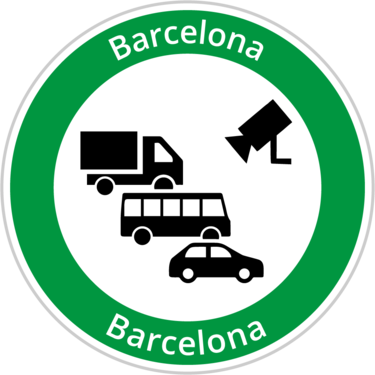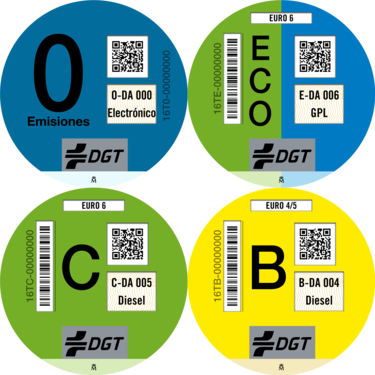Name of the environmental zone: Environmental Zone Sevilla ZPA - Spain
Date of entry into effect of the zone: 21-09-2018
Type of environmental zone: LEZ environmental zone, depending on weather conditions, where driving bans and traffic restrictions are activated following the announcement of an early warning stage.
Not allowed to drive (temporarily): If the city council officially declares an air pollution phase, then depending on the stage of an air pollution protocol, a speed limit and its driveways can be determined first. In further prohibition stages, only vehicles that have a Distintivo Ambiental may enter the environmental zone.
Not allowed to drive (permanently): Information currently unavailable
Fines: 90 €
Area/extension of the environmental zone: The environmental zone consists of the following 6 areas: Zona Oeste, Zona Sur, Zona Norte, Zona Centro, Zona Este, Zone Centro Este.
Contact of the environmental zone and exceptions: Information currently unavailable
Exemptions: Excavator, Disabled vehicle, Fire brigade, Military, Mobile cranes, Police car, Removal van, Sweeper, Public bus, Waste collection vehicle and Ambulance
Name of the environmental zone: Environmental Zone Seville ZBE Cartuja - Spain
Date of entry into effect of the zone: 01-01-2023
Type of environmental zone: permanently valid, Mon-Fri 7:00h-19:00h, public holidays excluded
Not allowed to drive (temporarily): Information currently unavailable
Not allowed to drive (permanently): Vehicle class: car, camper (M1), minibus (M2), van (N1), truck (N3)
Fuel type: diesel, petrol, LPG, LNG, CNG
Euronorm: 0-3 (diesel), 0-2 (petrol)
Sticker/registration/application: Entry only with sticker.
Note: Foreign vehicles do not need a sticker!
Fines: 200 €
Area/extension of the environmental zone: The zone covers the north and south of La Cartuja. The north is bordered by the streets: Leonardo Da Vinci, Juan Bautista Muñoz, José de Gálvez, Matemáticos Rey Pastor y Castro, Marie Curie, Avenida de Carlos III (with the exception of the car parks on the west side and their access via Hermanos d'Eluyar), the junction of SE-30 towards Glorieta Glorieta de la Vega and SE-30 towards Glorieta Olímpica until the junction with Américo Vespucio.
The south is bordered by the streets: Calle Marie Curie, Camino de los Descubrimientos, Francisco de Montesinos, Avenida de Carlos III (except for the car parks on the west side and their accesses).
Contact of the environmental zone and exceptions: 010Lineasevilla@sevilla.org
Exemptions: Fire brigade, Patient transport, Police car, Residents (registration/application necessary), Disabled vehicle (registration/application necessary), Taxi, Tow truck, Hearse and Ambulance
Name of the environmental zone: Environmental zone Sevilla ZTL - Spain
Date of entry into effect of the zone: 25-07-2014
Type of environmental zone: permanently valid, 0:00 - 24:00
Not allowed to drive (temporarily): Information currently unavailable
Not allowed to drive (permanently): Vehicle class: all
Fines: 50€ - 400 €
Area/extension of the environmental zone: The zone includes the historic district of Triana and the old town of Seville.
Special features: Video surveillance; permits required;
Contact of the environmental zone and exceptions: Dirección General de Movilidad
Edificio La Ranilla - Calle Clemente Hidalgo nº 2 - 4
41005 Sevilla
Tel.: 955 473 888
address.movilidad@sevilla.org
traficoytransportes@sevilla.org
direccion.movilidad@sevilla.org
Exemptions: Fire brigade, Police car, Residents (registration/application necessary), Disabled vehicle (registration/application necessary), Patient transport (registration/application necessary), Public bus, Hearse and Ambulance
Environmental zone ZBE
Do I need stickers or registrations?
To enter the low emission zone, each vehicle concerned needs either a registration (foreigners) or a Distintivo-Ambiental (Spanish vehicles). Otherwise, a fine of 200 euros to 1800 euros must be expected.
What is a ZBE zone?
The ZBE zones (Zona Baixes Emissions), are fixed zones that can be identified by traffic signs. They are designed to reduce air pollution in Spanish cities quickly and permanently.
A permanent ZBE zone is a zone in which permanent and fixed traffic restrictions apply, such as speed limits and other restrictions, and in which entry is regulated by a system of stickers. Furthermore, in the course of the next few years, stickers may be gradually removed from the system, so that vehicles with these stickers will no longer be able to enter the zones.
How do I recognize the low emission zone?
The beginning and end of the environmental zones are marked with signs. This shows a red circle as a prohibition sign with the remark Zona Baixes Emissions" (low emission zone). In addition, there is also a reference to the Distintivo-Ambiental stickers and which entrances are allowed.
In our Green Zones App we have a detailed map of each low emission zone. So you can easily see the boundaries and avoid penalties.
Are there other low emission zones in France?
Spain has a total of 7 different environmental zones. These differ in ZBE zones, ZEZ zones and ZPA zones: Barcelona, Madrid, Seville, Valladolid, Valencia.
In our Green Zones App we have gathered together all the low emission zones in Europe and presented them clearly.
Environmental zone ZPA
Do I need stickers or registrations?
If there is a peak in air pollution and the ZPA zone is activated, each affected vehicle requires a valid Spanish environmental sticker (Distintivo-Ambiental) to enter the low emission zone. Otherwise, a fine of 90 euros is to be expected.
You can find out whether a ZPA zone is active and which vignette is affected by the driving ban in our Green-Zones App.
What is a ZPA zone?
ZPA zones ("zones de protection de l'air") do not apply permanently, but are only active during bad weather and high air pollution. They can cover the areas of entire large municipalities or a specific geographical area. The outlines of each air protection zone are therefore precisely defined in advance.
Since ZPA zones are only valid in the event of a peak in air pollution, the traffic restrictions laid down in a decree only apply if predefined air pollution limits are exceeded. In this case, certain vignette colours are excluded from traffic in order to reduce pollutant emissions. For each air protection zone, recommendations have been drawn up in advance as to which vignette colours should be excluded in the event of severe air pollution. However, in the specific case of air pollution this is always decided by the prefect or mayor of the area.
How do I recognize the low emission zone?
ZPA zones are only activated temporarily. The size and dimensions of the zone are completely individual. This is determined by the respective prefect, depending on the intensity of air pollution. Therefore there are no special signs for ZPA zones.
In our Green Zones App we have a detailed map of each low emission zone. So you can easily see the boundaries and avoid penalties.
Are there other low emission zones in Spain?
Spain has a total of 7 different environmental zones. These differ in ZBE zones, ZEZ zones and ZPA zones: Barcelona, Madrid, Seville, Valladolid, Valencia
In our Green Zones App we have gathered together all of Europe's environmental zones and presented them clearly.
What is a traffic restricted zone (ZTL)?
A ZTL (Italian: Zona a Traffico Limitato) is a specific area in a city or region where vehicle access is restricted or limited in order to reduce traffic and emissions. These zones are often established in historic centers of cities or in residential areas to improve the quality of life for residents and reduce noise and exhaust pollution.
In a ZTL, for example, there may be bans on driving certain types of vehicles, such as older diesel vehicles, or restrictions on access at certain times of day. It may also be necessary to have a special permit or parking pass to drive in these zones.
Access to a ZTL is usually controlled via electronic monitoring systems, such as cameras or induction loops. Vehicle owners who violate the rules risk heavy fines.
The introduction of ZTLs has led to a reduction in traffic volumes in many cities.
Good to know...
All current driving bans and further information are available in our Green-Zones App.
Are night-time environmental zones coming?
The Berlin Green Party recently presented a proposal to equalise the traffic congestion in the capital. The idea is to shift delivery and commercial traffic to the night-time hours. According to Antje Kapek, transport spokesperson for the Greens, this proposal should help to ensure that delivery vehicles, refuse collection, care services and doctors get stuck less in congested and parked-up streets during the day. Low-noise and low-emission lorries could increasingly drive into cities at night and on special routes.
Bicycle instead of car - Paris in transition
A study by a public foundation has shown that more than one in ten journeys in Paris and the surrounding area are made by bicycle. This is a remarkable increase compared to 14 years ago, when less than one in thirty journeys were made by bike. Paris seems to have been endeavouring to change its transport policy for years. With more cycle paths and cycle lanes, fewer car parks and higher parking charges, the city is trying to promote cycling and reduce car traffic. But what does this mean for the existing low emission zone?



![[Translate to Englisch:]](https://www.green-zones.eu/fileadmin/_processed_/8/3/csm_screenshot_2024-04-18_125614_c7d9eca4a5.png)
![[Translate to Englisch:]](https://www.green-zones.eu/fileadmin/_processed_/2/0/csm_screenshot_2024-04-18_121908_5e1053efaf.png)